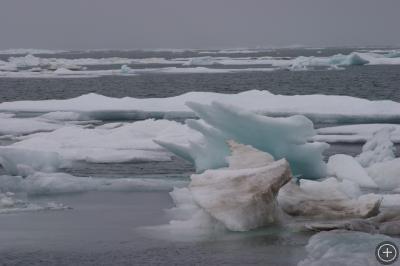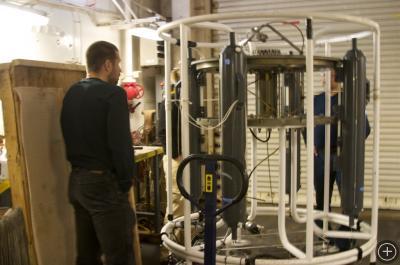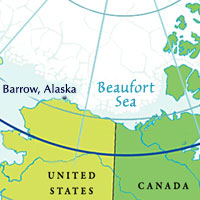Sea Ice Dynamics
ABOARD THE USCGC HEALY, ON THE BEAUFORT SEA– One of the things about the sea ice surrounding HEALY that cannot escape your attention is the fact it is neither all white nor flat and level. As shown in the image below, sea ice comes in various colors. After the onset of the cold season the sea freezes and ice covers the surface. Over the course of the winter, storms periodically induce stress in the ice unevenly, breaking it up and moving it around and compressing it together with great force to form ridges. The ridges above the surface are called sails, and those below the surface are called ice keels. It is these features which are of greatest interest to me because it is the ice ridges that are most hazardous to ships and shipping. The ridges are also important to the seals, which have very specific preferences the kind of ice they like in relation to the degree of ridging. The ice ridges are also of interest to the oceanographers on this cruise, who want to understand how these features interact with the winds, currents and tides in the ocean near the Beaufort Sea coast offshore of Alaska’s North Slope.
My friend Peter Wadhams has an excellent webpage describing how sea ice forms and decays, and its differences from freshwater ice (to see, click here). As he points out, because of the critical importance of sea ice to planetary climate, it is important for all of us to better understand the dynamics of sea ice. The principal difference of sea ice and freshwater ice is that when it forms initially sea ice includes salt from seawater. This makes it much more flexible and weaker than freshwater ice. But this changes over time as the ice ages and salt is gradually eliminated, so that second year ice which persists over a summer season is both fresher and much harder, particularly on our icebreaking ships when they are forced to break through zones of second year ice.
As a quick backgrounder to how much ice forms each year, and how much of it persists more than one year, I have collected several animations from colleagues which show some of this information. First, here is an animation which shows a typical annual cycle of ice in the Arctic for the first half of the year from Wieslaw Maslowski of the Naval Postgraduate School in Monterey, California:
Get the Flash Player to see this player.
Next, here is an animation by Wieslaw of sea ice thickness showing the area off the Canadian Arctic and northern Greenland where second year or multi-year ice commonly persists, and few if any ships, even icebreakers, dare venture:
Get the Flash Player to see this player.
Finally, here are two animations by Wieslaw that show cycles of stress in the ice. This one shows shear in the ice, arising from storms that open leads (cracks in the ice), which later close to form ice ridges:
Get the Flash Player to see this player.
And this one shows the stress as areas of convergence (blue) and divergence (red) in the pack ice of the Arctic during the winter months:
Get the Flash Player to see this player.
Ocean mixing and the effects of storms on sea ice are key components of the research being done by the scientists on this cruise. We are hoping to better understand the mixing of the waters in the Arctic and heat transport from lower latitudes and coastal Arctic waters to the depths of the Arctic Ocean.
The first science operations on HEALY began shortly after everyone was aboard, in the traditional way: by ‘grabbing water.’ This is done using a circular metal frame called a rosette, from which water sampling bottles, called Niskin bottles (named after their inventor) are lowered in an open position into the ocean, and a closure mechanism is electronically activated to capture water from various depths.
Along with the Niksin bottles, the rosette includes a CTD. CTD stands for conductivity, temperature and depth; a CTD “cast” (vertical lowering and raising) allows a profile of salinity with depth to be calculated from conductivity of seawater once corrected for temperature and depth. These vertical casts profile the heat content of the Arctic Ocean, and mixing of coastal waters freshened by rivers with the deeper ocean waters. Whereas this is one of the main goals of this cruise, the work is underway: not bad for a first day at sea. And on the morrow the science will start in earnest, hopefully still amid the ever-fascinating ice.

 No comments
No comments 










